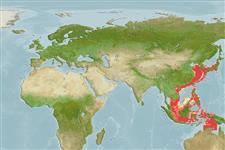>
Scombriformes (Mackerels) >
Scombridae (Mackerels, tunas, bonitos) > Scombrinae
Etymology: Scomberomorus: Latin, scomber = mackerel + Greek, moros = silly, stupid (Ref. 45335).
More on author: Lacepède.
Environment: milieu / climate zone / kisaran kedalaman / distribution range
Ekologi
laut; air tawar; payau pelagic-neritic; amphidromus; kisaran kedalaman 10 - ? m. Subtropical; 41°N - 14°S, 102°E - 140°E (Ref. 168)
Western Pacific: Akita, Honshu, Sea of Japan, Yellow Sea and China south to Vietnam and Cambodia where it enters the Mekong River.
Size / Weight / umur
Kematangan: Lm ? range ? - ? cm
Max length : 247 cm TL jantan/; (Ref. 83530); common length : 100.0 cm TL jantan/; (Ref. 27773); Berat maksimum terpublikasi: 131.00 g (Ref. 83530)
Duri punggung (Keseluruhan (total)) : 15 - 17; duri punggung lunak (Keseluruhan (total)) : 15 - 17; Duri dubur: 0; Sirip dubur lunak: 16 - 19; vertebrata, bertulang belakang: 41 - 42. Interpelvic process small and bifid. Body covered with small scales. Lateral line abruptly curving down below first dorsal fin. Intestine with 2 folds and 3 limbs. Swim bladder present. Sides silvery with large round, indistinct spots in two poorly defined rows in adults. Juveniles with saddle-like blotches extending down to about middle of body.
Body shape (shape guide): fusiform / normal; Cross section: oval.
Travels 300 km up the Mekong River, above Phnom Penh but believed to reproduce only in marine waters. Feeds on fishes and swims well upstream river because of easy food availability (Ref. 12693). No information on biology available (Ref. 9684). It is a prized food fish in Japan and probably in China as well. Utilized fresh, dried or salted and smoked; consumed pan-fried, broiled and baked (Ref. 9987).
Life cycle and mating behavior
Kematangan | Reproduksi, perkembang biakan | Pemijahan | telur-telur | Fecundity | Larva
Collette, B.B. and C.E. Nauen, 1983. FAO Species Catalogue. Vol. 2. Scombrids of the world. An annotated and illustrated catalogue of tunas, mackerels, bonitos and related species known to date. Rome: FAO. FAO Fish. Synop. 125(2):137 p. (Ref. 168)
Status IUCN Red List (Ref. 130435: Version 2024-2)
ancaman kepada manusia
Harmless
penggunaan manusia
Perikanan: komersial; Ikan buruan: ya
Alat, peralatan
laporan khas
muat turun XML
Sumber internet
Estimates based on models
Preferred temperature (Acuan
123201): 11.9 - 28.3, mean 26.6 °C (based on 719 cells).
Phylogenetic diversity index (Acuan
82804): PD
50 = 0.5000 [Uniqueness, from 0.5 = low to 2.0 = high].
Bayesian length-weight: a=0.00851 (0.00392 - 0.01850), b=3.03 (2.86 - 3.20), in cm total length, based on LWR estimates for this Genus-body shape (Ref.
93245).
Trophic level (Acuan
69278): 4.5 ±0.80 se; based on food items.
Daya lenting (Acuan
120179): Rendah, Waktu penggandaan populasi minimum 4.5 - 14 tahun (Preliminary K or Fecundity.).
Fishing Vulnerability (Ref.
59153): Very high vulnerability (90 of 100).
🛈
